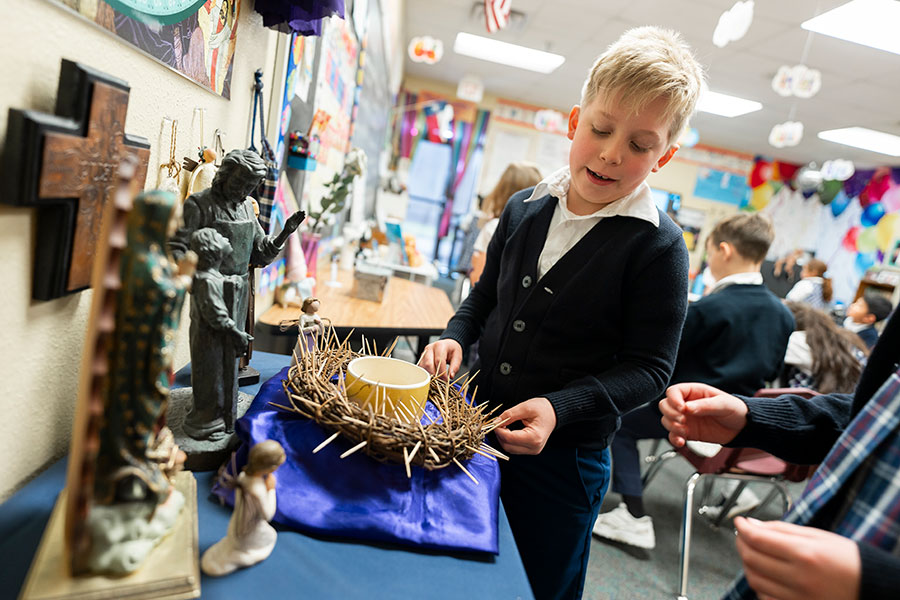Pint-sized ashes: the sacrifice of Ash Wednesday and Lent through the eyes of a child

Students work on a Lenten craft in Debbie Heid's second-grade classroom at St. Joseph Catholic School in Arlington on February 14, 2024. (NTC/Juan Guajardo)
The mysteries and meaning of Lent can be challenging to comprehend for even the most pious adult. For young children learning about this important Catholic season, teachers must adopt a thoughtful and intentional approach to conveying these concepts in age-appropriate ways.
In Mary Pilkington’s pre-K through first-grade classrooms at St. Martin de Porres Catholic School in Prosper, she begins her Ash Wednesday lessons at least a week before the day so that by the time it arrives, the children are aware of what is happening and more engaged.
Explaining advanced topics, such as the death and rising of Christ and the meaning of His sacrifices, holds both challenges and opportunities for a teacher. Every new grade level results in a jump in understanding, and meeting each child where they are requires patience and repetition.
One child told Pilkington he was afraid of the ashes, motioning to his forehead. After asking him why, she realized his only conception of ashes was from a fire, and he thought it would burn him. Similarly, many children have unexpected preconceived notions she must identify and address before she can adequately explain this liturgical season.
With these younger ages, she explains mainly through visuals and stories.

“The youngest ones are best at explaining orally,” she explained. “That’s how I know they understand it. I can ask them what the color of Lent is. The first graders can draw pictures, label, and share their thoughts with a partner or the class.”
She also involves their parents to help the children determine what would be good to give up or do for Lent. While many of the children initially make the classic joke that they’ll give up broccoli or something similar, they discuss the meaning of sacrifice together, and each chooses something meaningful to them.
As a class, they attend weekly Thursday Mass and participate in Stations of the Cross and the Rosary, which Pilkington explains beforehand.
According to Pilkington, children have an easier time grasping some of the concepts taught in her class than adults do.
“The kids just accept everything as you tell them,” Pilkington said. “When you tell them God loves them, they believe it. When you tell an adult that, they have trouble. The little ones are so excited about new things. Sometimes, adults forget the wonder. The kids are so excited about all the brand-new things.”
Teaching one grade level older, Debbie Heid works as a second-grade religion teacher at St. Joseph Catholic School in Arlington.
She also strives to reinforce the ideas behind Ash Wednesday and Lent through repetition. Every day, her classroom participates in one Lent-focused activity and a nightly homework assignment.

This is the age that her students will receive the sacraments of reconciliation and holy Communion, so she believes they start to grasp more and understand the gravity of Jesus’ sacrifices a bit better. It’s also exciting for them to receive the ashes in the line at Mass, just like they know they’ll soon receive the Eucharist.
Like Pilkington, Heid works to create visual reminders of the season. She decorates the classroom in purple and puts out a crown of thorns made from toothpicks. Each time the students do a good deed, they get to remove one “thorn” from the crown to show how their actions help Christ. Weekly Mass and Adoration also reinforce the messages she teaches in the classroom.
“I try to stress that Lent is about change. It is not a temporary thing that we do; it is something that we are going to try to continue,” she said. “If you’ve done your Lent right, you come out closer to God. I see some of these kids really come out of Lent as better people, and that is my reward — that I see that they are really concentrating, working, and trying to do their best.”
One thing she’s found especially helpful with this age group is showing them actual photos of the locations found in the biblical stories she tells. These photos show them Jesus was, in fact, a real person who indeed suffered — not simply a storybook character.
Heid feels this age group takes the lessons exceptionally well. She leads the students through guided meditations throughout Lent, through which many students begin to feel closer to God.
“That’s the beauty of second graders — they want to know God,” she said. “They really, really do. I believe that all of these little things we do in the classroom help them start to feel closer to God.”
For Heid and Pilkington, the lessons they teach extend beyond the season of Lent. They hope students will take the skills and experiences taught in the classroom through prayer and continue to share Christ’s light even after Easter.
“They’re impressionable at this age, and they just get it. They’re bringing themselves closer to God. They remind me how special this is and how beautiful the faith is,” Heid said.
